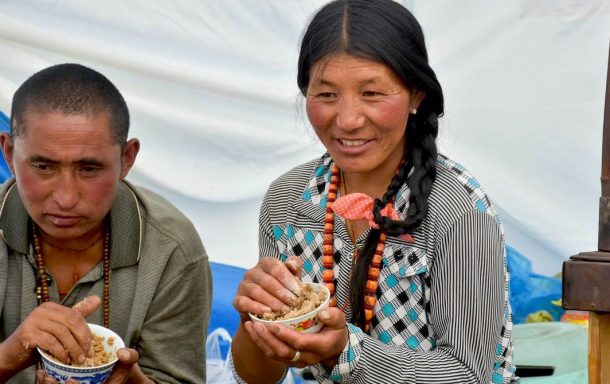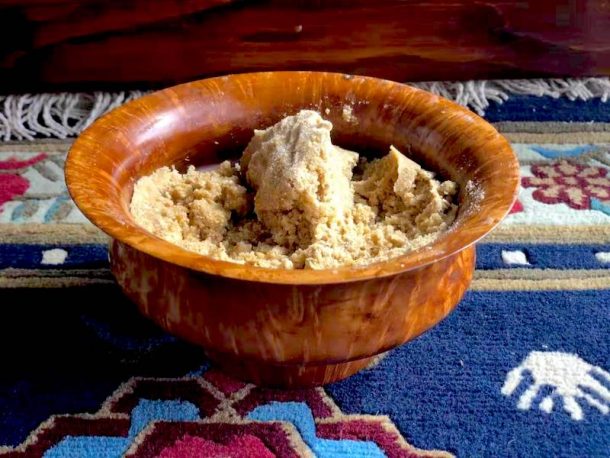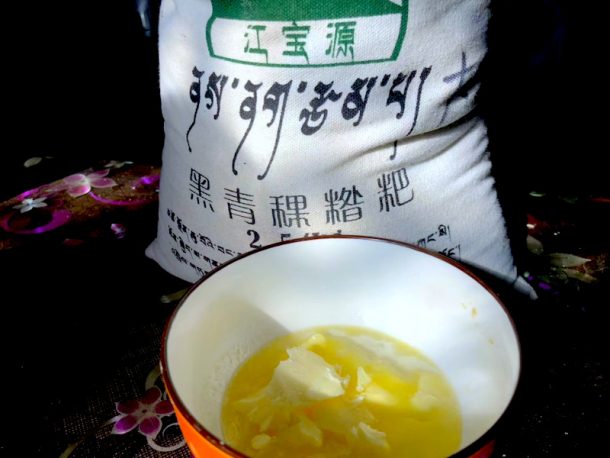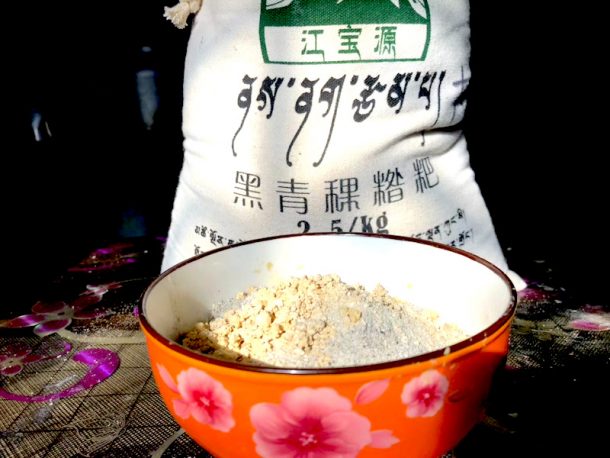The Mystic Delights of Tibetan Tsampa
Many travelers to the Tibet Autonomous Region have some trepidation about trying out the local cuisine. Websites tell you it is mostly mutton and yak meat or there is a lack of ingredients for many dishes so you may not like it. In truth, Tibetan cuisine is one of the tastiest of the cuisines in this area of Southern Asia, and even in the most remote regions of the plateau, you can always find plenty of tasty, plateau dishes that will tease and tantalize your taste buds.

However, there is one single dish on the plateau and in all areas where Tibetan people live that is probably the epitome of Tibetan food – Tibetan Tsampa. Whether it is used for snacks, meals, religious rites, or blessings this amazing highland barley flour is as much part of the Tibetan culture as yaks, monasteries, and monks.
Table of Contents
Tsampa – The First Food of Tibet
The most culturally significant food on the plateau Tsampa is made from highland barley flour and has been a staple of Tibetan diets for millennia. The hardy Tibetan barley, known as “qingke”, has been the main cereal crop in Tibet for around 3,500 years, and its introduction allowed the ancient Tibetan nomads to climb higher onto the plateau to farm. But this predominant staple is not just a portion of food and is used in religious rituals in Tibetan Buddhism in many ways.
Similar to coarse cornmeal, tsampa flour is coarse ground from roasted barley, which gives it a distinctive nutty flavor that improves the taste. Often made using the tea in the bottom of the bowl, Tibetan’s eat this delicious treat for breakfast, as an addition to the daily meals, and as a snack for both kids and those on a pilgrimage. And it is not just the balls of dough made from tsampa flour and tea that you can eat. It can also be made into a tasty porridge known as “thuma”, which is often found in many tents in the nomadic communities in the morning.
Tsampa in Tibetan Buddhism
The celebration of religious rituals using tsampa flour actually pre-dates Buddhism in Tibet and has many uses in Tibetan Buddhism as part of the ritual offering during ceremonies. At weddings, revelers toss the flour into the air as an expression of their joy at the new union, and it is also thrown at times of births, during Losar (Tibetan New Year), and during many other religious ceremonies.

It can be found given as offerings on many altars and shrines, including in the Jokhang Temple, at the status of the Jowo Rinpoche. And on the passing of a loved one, it is also burned during the 49-day mourning period of their close family. Tibetan families believe that the burning tsampa flour will help release the soul from the body and carry it on to the next life.
Tsampa is also used in making forms of cakes for use as gifts to visitors and relatives in Tibet. Tsampa, with its religious connotations and uses, is considered to be a treasured gift to both give and receive and is often donated to a birthday celebrant as part of the celebrations of life.
Tsampa in Tibetan Medicine
The flour is also widely believed to have some medicinal properties, though this has never been proven in a proper laboratory. Commonly applied to the teeth and gums, the flour is believed to help give relief from a toothache, and can be used as a massage compound to help aching necks or headaches. And all Tibetans know of its properties as a quick energy boost for the elderly and those on long journeys. Tsampa flour is probably the most diverse and profound food on the entire plateau.

How to Make Tibetan Tsampa
The ultimate in soul-food for Tibetans, making Tibetan tsampa can be done by yourself, or it can be done as a family. And everyone in Tibet is an expert at rolling out the balls of tsampa for eating in the household. Normally, the main ingredient is the barley flour, though in some regions of Tibet people can add things like chura – a sharp dry cheese – to the mix along with some yak butter (which actually should be called “dri butter”, since only the female can produce the milk it is made from).
Sweeteners such as brown sugar can be added before you introduce the famous Tibetan tea to the bowl of flour. The type of tea is really based on the region, and Tibetans will use milk tea, butter tea, or black tea, depending on where they are from. If you are making tsampa as a family, then the bowls are pre-prepared by the woman of the house and handed out in order of age, oldest to youngest of the males, then oldest to youngest of the females.

The trick to making good Tibetan tsampa is to not over-knead the dough. The flour and tea are mixed with your index finger, poking a hole in the edge of the flour first and then gently mixing in the water. In a form of delicate finger-dance around the bowl, the flour and tea are gently folded in together until the ingredients form a neat ball in your hand. The trick to good tsampa is getting the right proportions of tea to barley flour, as well as the deftness of the fingers in mixing the two together.
In Tibet, tsampa is as easy to make as a cup of instant coffee in the west, and you rarely even have to boil the kettle first. Most homes in Tibet have hot tea on the go all day long, so it is simple and easy to whip up a quick batch of tsampa when visitors stop by. A massive part of the Tibetan culture, this unique food has had a part in the entire history of Tibet since its earliest beginnings in the Yarlung Tsangpo Valley in Lhoka.
Tibetan Tsampa is actually so ingrained into the ancient lore of Tibet, it has a place in almost every part of the typical Tibetan culture. And if there is anything that reflects the culture and roots of Tibet so profoundly, it is Tsampa. It is even the name of a popular typeface in Tibet these days. Quite a transition into the 21st century for an 8,000-year-old cereal.
Recent Posts
Journey to Tibet
Exploring Tibet
The Best Tibet Tours for Every Adventurer
All Categories
- About Tibet
- book a Tibet tour
- Buddhism Practice
- Budget Tour
- China-Tibet Train
- Customized Tibet tour
- Historical Sites
- Hot Springs in Tibet
- News
- Photography in Tibet
- Tibet attraction
- Tibet Group Visa
- Tibet Motorcycle Tour
- Tibet Small Group Tours
- Tibet Tours and Tibetan Tour Guide
- Tibet Train
- Tibet Travel FAQs
- Tibet Travel Information
- Tibet Travel News
- Tibet Travel Permit Update
- Tibet Travel Prices Rises
- Tibet Trek
- Tibet Trekking Tour
- Tibet weather and climate
- Tibet Wildlife animals
- Tibet Winter Tour
- Tibetan Buddhism
- Tibetan Cultural Features
- Tibetan Culture and Poeple
- Tibetan Festivals
- What to see in Tibet



